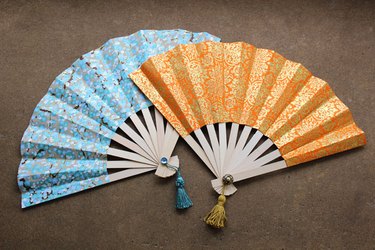
Japanese folding fans, also known as sensu, are as beautiful as they are functional. Fashioned out of decorative paper and wood, you can make your own in just a few simple steps.
Video of the Day
Things You'll Need
Decorative wrapping paper
Plain white paper
Wood sticks, 11 in. long by 1/2 in. wide
2-in. head pin
Push pin
Compass drawing tool
Scissors
Needle-nose pliers
Paintbrush
Pencil
Glue
Tassel
Button
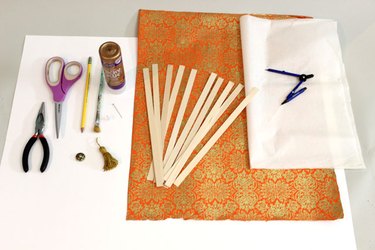
Japanese fans are typically made with bamboo, but flat bamboo sticks are difficult to find. As a substitute, basswood strips work just as well. Basswood is similar to balsa wood, except it's more durable. You can find basswood sticks in craft stores and hobby shops.
The fan in this project uses 11-inch-long sticks that were 1/2 inch wide and 1/16 inch thick. If your local store only sells basswood sheets that are larger than you need, they can easily be cut to size with a hobby knife. You will need 10 wood sticks to make a fan.
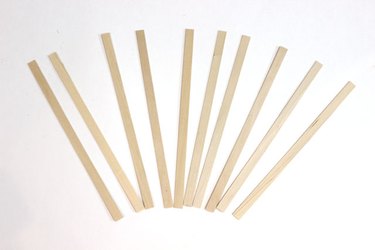
Japanese folding fans are as functional as they are beautiful!
While they certainly do offer assistance in cooling down on a warm day, the folding fan has numerous traditional functions in the Japanese culture. These beautifully decorated objects play a role in dances performed to express prayers to the gods. They are also commonly used in Japanese tea ceremonies and in the art of storytelling.
1. Pierce a hole in each wood stick
Measure 1 inch from the end of each wood stick and puncture a hole at the midpoint with a push pin. Place a cutting mat underneath the wood so the pin can go all the way through.
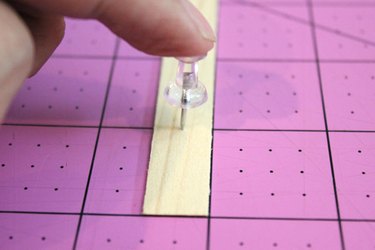
2. Insert a head pin through the sticks
After piercing a hole in all 10 wood sticks, stack them up and thread a 2-inch head pin through the holes.
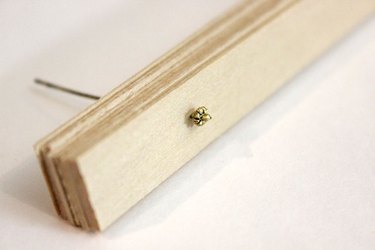
3. Close the other end of the head pin
Using needle-nose pliers, twist the other end of the head pin to keep the pin from sliding out. The pin should keep the wood sticks tight but still allow for pivoting.
Tip
Don't worry if the twisted head pin is not that attractive. You will cover it with a button later.
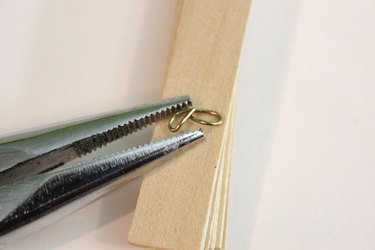
4. Draw an arc on white paper
This fan features two types of paper: decorative paper in front and plain white paper in the back that serves as a lining. The white paper gives more heft to the fan and helps to cover the wood sticks. Thin rice paper was used in this project, but you can use any plain paper. Cut the paper to about 15 inches by 18 inches. Use a compass set at a 4-inch radius to draw an arc at the edge of the paper and cut out the half circle.
Tip
You can also trace a round plate if you don't have a compass.

5. Position the wood sticks
Position the wood sticks on the white paper with the pivot point at the bottom center where the half circle was removed. This way, about 4 inches of the wood will be exposed, with the rest covered by the white paper. Arrange the sticks so they are evenly spaced.
Tip
The total span of the sticks should be between 90 and 180 degrees.

6. Trace an outline of the sticks
Once the sticks are positioned exactly where you want them, trace around them with a pencil. You will remove the sticks in the next step, so tracing them will help you keep track of their correct position. You won't see the pencil marks when you're finished.
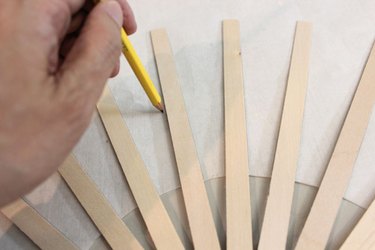
7. Glue the back of the sticks
Apply glue to the back of the sticks using a paintbrush. Only apply glue to the top portion of the sticks.
Tip
Using a brush will give you a more even coat of glue on the wood.
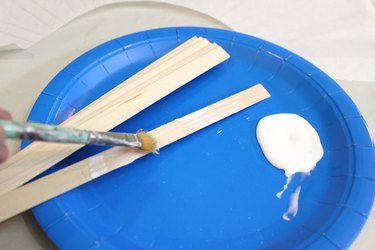
8. Return the fan sticks to the paper
Place the wood sticks on the paper with the glue side down, using the pencil marks you traced earlier to return the sticks to the correct position. Press on the sticks with your fingers to make sure the glue makes contact with the paper.
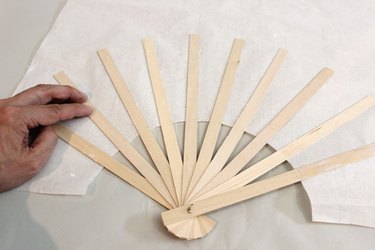
9. Trim roughly around the fan sticks
So that the fan is easier to work with, use a pair of scissors to trim about 1 inch all around the wood fan sticks. You can approximate at this point, as this is not the final shape of the fan.
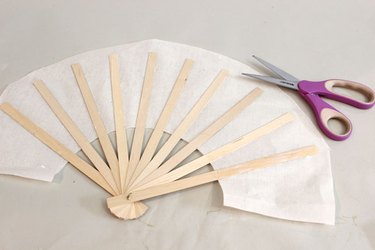
10. Cut a half circle in the decorative paper
Choose a decorative paper that folds easily, like wrapping paper or origami paper. The paper should be about 15 inches by 18 inches. Just as you used the compass to measure an arc in the white paper, do so with the decorative paper and cut out the half circle. You want this arc to be slightly smaller than the one on the white paper, so set the compass to about 3 3/4 inches.
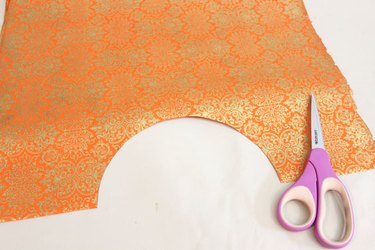
11. Apply glue to the front of the fan
Use a brush and apply glue to the front of the wood sticks, only where they make contact with the paper. It's also a good idea to dab a little glue on the paper between the sticks so that the decorative paper will adhere to the white lining.
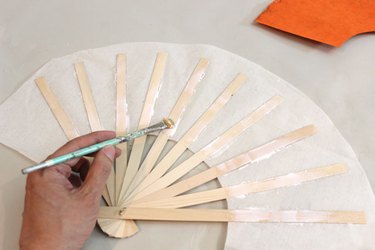
12. Position the back of the fan onto the front
Turn over the fan (glue side down) and adhere it to the "wrong" side of the decorative paper. Make sure the two half circles at the bottom line up, with the decorative paper extending past the white lining by about 1/4 inch. Run your fingers across the paper to smooth it out.
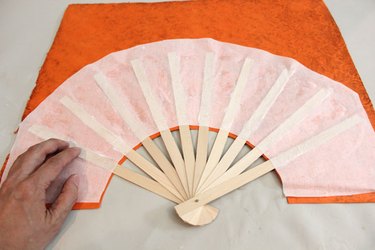
13. Trim to your finished size
Use the tops of the fan sticks as a guide and cut all around the top of the fan. Cut right up to the tip of the sticks. Leave about 1/2 inch of paper on the left and right edges of the fan.

14. Cover the ends with decorative paper
On the wood sticks at the very left and right edge, apply some glue and fold the decorative paper onto it. This way, you will have finished edges when the fan is folded.
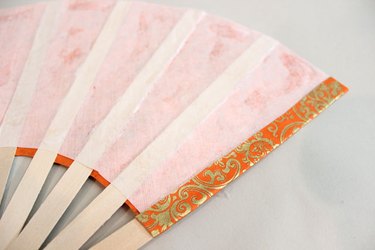
15. Fold the fan
Fold the fan, lining up the wood sticks. The paper will fold up along with the sticks. Give the paper a strong crease so that the pleats will show when the fan is unfolded.
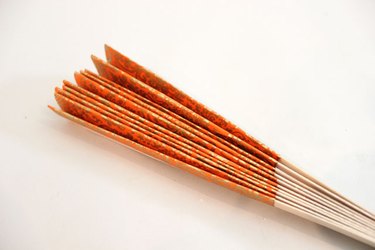
16. Add a tassel
Hook a tassel onto the twisted knot of the head pin. Give it a tug to make sure it won't slip off.
Tip
Choose a tassel that will coordinate with the fan.

Glue a decorative button on top of the twisted part of the head pin. The button hides the twisted metal and locks the tassel into place. It helps if the button is concave in the back so that the head pin can sit in the cavity.
